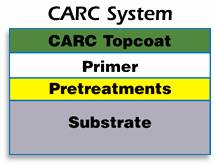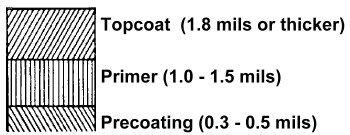

CARC resists corrosion and the penetration of chemical agents. It does not soak up chemical agents the way alkyd paint does. It also resists removal by decontaminating solutions.
CARC is required on all combat, combat support, and combat service support equipment.
Major end items and major components with exposed surfaces painted with CARC will have the word "CARC" stenciled on them in close proximity to the data plate.
Solvent-Based CARC Paints:
- MIL-C-46168 a two-component aliphatic polyurethane used on exterior surfaces and those interior surfaces frequently exposed (eg, ramps, hatches). Cancellation due September 2005. Replacement with MIL-DTL-64159 and MIL-C-53039
- MIL-C-53039 a single component aliphatic polyurethane used wherever MIL-C-46168 may be used.
- MIL-C-22750 a two-component epoxy polyamide enamel used only on interior surfaces.
Chemical agent resistant coating (CARC) paint contains isocyanyte (HDI), which is highly irritating to skin and respiratory system. High concentrations of HDI can produce symptoms of itching and reddening of skin, a burning sensation in throat and nose, and watering of the eyes. In extreme concentrations, HDI can cause cough, shortness of breath, pain during respiration, increased sputum production, and chest tightness. The following precautions must be taken whenever using CARC paint:
- ALWAYS use air line respirators when using CARC paint unless air sampling shows exposure to be below standards. Use chemical cartridge respirator if air sampling is below standards.
- DO NOT let skin or eyes come in contact with CARC paint. Always wear protective equipment (gloves, ventilation mask, safety goggles, etc.).
- DO NOT use CARC paint without adequate ventilation.
- Mixed CARC is extremely flammable. Use only in well-ventilated areas. Keep away from open flames, sparks, and other ignition sources.
- DO NOT use CARC for items like manifolds and mufflers that exceed 400°F. Doing so may produce toxic fumes and/or equipment damage.
- NEVER weld or cut CARC-coated materials.
- DO NOT grind or sand painted equipment without high-efficiency air purifying respirators in use.
- BE AWARE of CARC paint exposure symptoms; symptoms can occur a few days after initial exposure. Seek medical help immediately if symptoms are detected.
- Unusable chemical agent resistant coating (CARC) mixtures are considered hazardous waste.
Notes on use:
- CARC colors should not be mixed with one another as this will alter their individual effectiveness when applied to the end item. Blending is not permitted.
- Do not use CARC on items which are flexible. Because of its rigidity, the finish may crack when item is bent.
- Do not use CARC on rubber, lacquer coatings, or vinyl.
- CARC is not used on fabric, metals that have anodized or parkerized finishes (like weapons).
- CARC won't last as well on wood. Wood expands and contracts with weather changes. CARC does not. It is not flexible enough to move with the wood, so it cracks and can peel off.
MIL-DTL-64159 Water Dispersible CARC:
- The replacement for solvent-based CARC (MIL-C-46168)
- Contains water and is thinned with water.
- The solvent content of WD CARC is less than half that of solvent-based CARC. It also contains no hazardous air pollutants.
- Is fully compatible with all existing CARC primers and topcoats,
- Is more flexible after application.
- Is more durable and doesn't scratch as easily as the old CARC.
- Is much more durable in all weather conditions.
- Doesn't fade like the old CARC.
- The personal protective equipment required during spray and brush application remains the same as for solvent-based CARC.